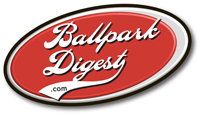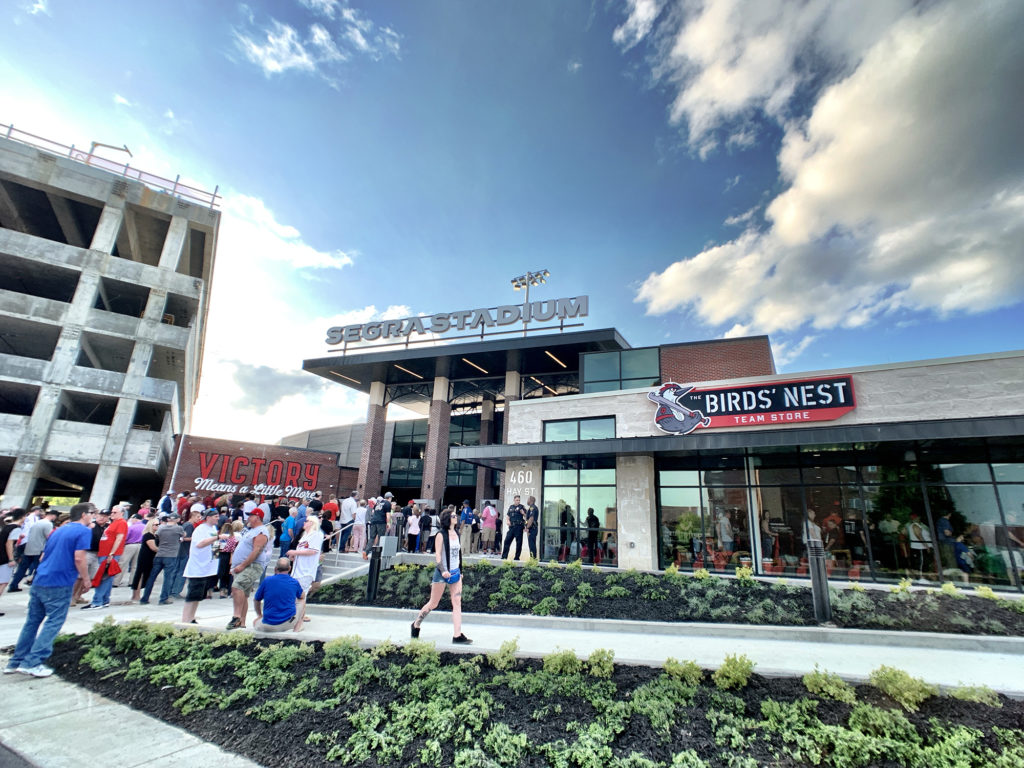The Fayetteville Woodpeckers (High A; Carolina League) debuted in 2019 with a strong brand that resonated with its blend of traditional and modern tastes, ties to the community, and recognition of the military. For those reasons, the Woodpeckers are being cited with our 2019 Best New Logo/Branding Award.
“It feels humbling to win the award,” said Woodpeckers President Mark Zarthar. “As so many other teams can attest to, there’s plenty of work that goes in not only to the brand launch, but in to the year leading up to the brand launch and there are so many other brands that were launched this year that were are big fans of—the Sod Poodles, the Aviators, and the Trash Pandas. To see us win the award is very humbling. Any one of those teams could have also won this award, but it’s a testament to our staff here and in Houston to put together a fantastic product for our community.”
The Woodpeckers identity was several years in the making. The Houston Astros-owned franchise began play in 2017—when two teams were shifted from the California League—as the Buies Creek Astros, staging home games at Campbell University’s Jim Perry Stadium while awaiting the completion of a new ballpark in downtown Fayetteville. Five finalists for a potential name were revealed in June 2017, with Woodpeckers part of a field that included Wood Dogs, Fatbacks, Fly Traps and Jumpers. That culminated in last fall’s unveiling of the Woodpeckers moniker, complete with logos, colors, marks, and uniforms.
The name carries a strong connection to the local community and nearby Fort Bragg, a tie-in we noted at the time of the announcement:
The Woodpeckers name is also specific to the greater Fayetteville area, referring to the endangered red-cockaded woodpecker, one of the initial species named when the Endangered Species Act of 1973 was passed. Once plentiful in Fayetteville and North Carolina, numbers of the red-cockaded woodpecker dwindled until city and Fort Bragg officials took measures to preserve habitats and apply best practices to boost the population. The Fort Bragg changes were extensive, as training grounds were shifted and nesting habitats marked to diminish impacts on the red-cockaded woodpecker. The actions taken by Fort Bragg leadership was particularly effective, Zarthar said, earning them recognition for a model that spread across 30 states. Today, the area is home to the second-largest population of endangered red-cockaded woodpeckers.
It was immediately clear with its sleek look and feel, including red and black colors that tie to the woodpeckers and match the insignia of the U.S. Army Special Operations Command—headquartered at Fort Bragg—that the brand had the potential to stand out. Since its roll out, the brand has clearly caught on, thanks to an embrace by members of the Fayetteville and Fort Bragg communities and a ballpark design that takes some inspiration from the team’s identity.
According to Zarthar, the Woodpeckers ended up having over $1.2 million in merchandise sales. Over time, it became more common to see Woodpeckers apparel being worn around the community, reflecting an embrace of the team’s identity.
“I think that $1.2 million in merchandise sales is a great number from a budget perspective, but more than that, you see more than $1.2 million in merchandise walking around Fayetteville,” said Zarthar. “You go to the grocery store, walk around downtown, [go to] high school football games, and there’s Woodpeckers hats and t-shirts everywhere. The community hasn’t had something like this in a long time, and so to see everyone embrace this professional baseball team and welcome us to the community was really big.”
Segra Stadium, the team’s $40-million ballpark that opened in April, draws heavily from the Woodpeckers branding. In planning the project, officials from architecture firm Populous, the Woodpeckers and City of Fayetteville took proactive steps to incorporate the team’s color scheme into the ballpark, leading to a look and feel that is a bit different most professional baseball facilities and adding to the team’s objective to recognize Fort Bragg.
“It was important to the Woodpeckers, Populous and the City of Fayetteville to pay tribute to and take inspiration from nearby Fort Bragg,” said project architect Aaron Noll. “We also wanted the Fayetteville ballpark to have a unique and contemporary feel and wanted to use colors in the design of the ballpark that weren’t traditional baseball colors, such as dark green or blue. When you’re out at Fayetteville, you’ll notice the outfield wall pads are black, the structural steel is black, which is definitely a unique color in those circumstances and it also matches the team color.”
In addition, a few other elements at Segra Stadium that help build the connection to Fort Bragg, including branded concessions such as Bowley’s BBQ—named after Albert J. Bowley, a Lieutenant General in the U.S. Army who was the commander of Fort Bragg from 1921-1928—and Sherwood Steaks, a tribute to Sherwood Hallman, a Medal of Honor recipient who served in World War II. Other unique touches include gray seats, and a mural outside the ballpark that reads Victory Means a Little More Here.
“I think the biggest strength isn’t just the design of the branding, but I know that the city and the Woodpeckers put a big emphasis on creating kind of a bigger connection to the military,” said Noll. “They really wanted to bring out the military service members and their families, and make them really feel like part of the community and give them an entertainment venue that they felt comfortable bringing their families to and feel like they were part of what the city was doing.”
The mural is also reflective of how the Woodpeckers take their role in downtown Fayetteville’s aspirations of a revival seriously. Segra Stadium is planned as part of a larger downtown redevelopment project that includes the renovation of the adjacent Prince Charles Hotel into apartments, new office space, a new Hyatt Place hotel, a parking structure, residential and retail. Building off inspiration from other cities, the Woodpeckers, Fayetteville, and the Fayetteville Area Convention & Visitors Bureau wanted the mural to become the backdrop of memories for tourists and residents alike.
“For us, it was something that was not necessarily just about the baseball stadium but was about how the stadium is part of the broader redevelopment for downtown Fayetteville,” said Zarthar. “You go to a place like Nashville, you go to a place like Austin or these more touristy cities, you often see a mural that is very popular to take pictures in front of. We took inspiration from those cities and determined that downtown Fayetteville needs a place where people can take their picture in front of and feel proud to share that they are from here or that they visited here.”
In addition, the Woodpeckers also successfully worked the brand into their uniforms. Rather than go with a cartoonish look, the team was able to work in a realistic and fierce logo that works well in its display on caps, and home, road, and alternate jerseys.
“I think when people initially heard the woodpeckers, their initial thinking was ‘oh, like Woody Woodpecker, a cute bird,’” said Zarthar. “The reality is we think of the Woodpeckers as this fierce bird and, while it’s been endangered for a period of time, it refuses to become extinct. When you look at our uniforms and the bird on our hat is not a lovable woodpecker, it’s a fierce woodpecker.”
Ultimately, the Woodpeckers worked to create a brand that they not only wanted to resonate with immediate buzz but start what will be a lasting look for decades to come.
“I think it’s a challenging proposition, because one you want to create a spark in the community, you want to create a spark with your potential fanbase that creates plenty of PR value locally, regionally, and potentially nationally as well,” Zarthar said. “At the same time, you also want to accomplish launching a brand that will be well received in your community for the next handful of decades, so it’s a balance of creating a spark but also have a brand that can maintain popularity for a long period of time. Balancing those and creating the right, perfect brand was our greatest challenge.”
Past Ballpark Digest Logo/Branding of the Year winners:
2018: Copa de La Diversión
2017: Down East Wood Ducks
2016: Columbia Fireflies
2015: Daytona Tortugas
2014: Akron RubberDucks
2013: Hillsboro Hops
2011: Joliet Slammers
2010: Richmond Flying Squirrels
2019 Awards
Best New Food Item: Crabzilla, Pensacola Blue Wahoos
Best New Concessions Experience: Pensacola Blue Wahoos
MiLB Broadcaster of the Year: Jesse Goldberg-Strassler
Promotion of the Year: Funko Fridays
Best Ballpark Improvement (Over $1M): City of Baseball Museum
Ballpark of the Year: Las Vegas Ballpark
Team of the Year: Las Vegas Aviators
Best Ballpark Renovation: American Family Fields of Phoenix




